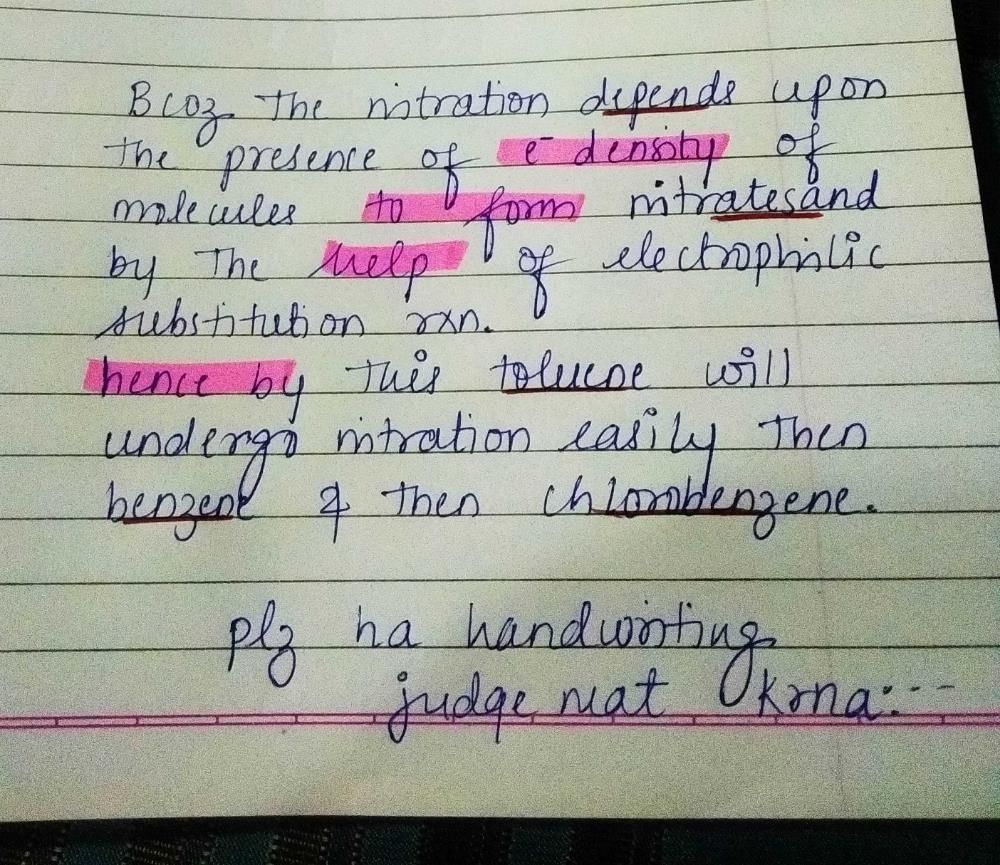Class 11 Exam > Class 11 Questions > Out of benzene, chlorobenzene, and toluene wh...
Start Learning for Free
Out of benzene, chlorobenzene, and toluene which one will undergo nitration more easily and why?
Most Upvoted Answer
Out of benzene, chlorobenzene, and toluene which one will undergo nitr...
Nitration of Benzene, Chlorobenzene, and Toluene
Introduction
Nitration is the process of introducing a nitro group (-NO2) into an organic compound. Benzene, chlorobenzene, and toluene are aromatic hydrocarbons that can undergo nitration. However, the ease of nitration depends on the nature of the substituent present in the molecule.
Nitration of Benzene
Benzene is a highly stable aromatic compound due to the presence of delocalized electrons in the ring. However, it can undergo nitration in the presence of a mixture of concentrated nitric acid and concentrated sulfuric acid. Nitration of benzene leads to the formation of nitrobenzene.
Nitration of Chlorobenzene
Chlorobenzene is less reactive than benzene towards electrophilic substitution reactions due to the electron-withdrawing effect of the chlorine substituent. The chlorine atom withdraws electron density from the ring, making it less nucleophilic and less susceptible to attack by electrophiles. Hence, chlorobenzene undergoes nitration at a slower rate than benzene.
Nitration of Toluene
Toluene is more reactive than benzene towards electrophilic substitution reactions due to the presence of a methyl group (-CH3) as a substituent. The methyl group is electron-donating and increases the electron density on the ring, making it more nucleophilic and more susceptible to attack by electrophiles. Hence, toluene undergoes nitration more easily than benzene.
Conclusion
In summary, of benzene, chlorobenzene, and toluene, toluene undergoes nitration more easily due to the presence of a methyl group as a substituent. Benzene can also undergo nitration, but chlorobenzene is less reactive towards electrophilic substitution reactions due to the electron-withdrawing effect of the chlorine substituent.
Community Answer
Out of benzene, chlorobenzene, and toluene which one will undergo nitr...

Attention Class 11 Students!
To make sure you are not studying endlessly, EduRev has designed Class 11 study material, with Structured Courses, Videos, & Test Series. Plus get personalized analysis, doubt solving and improvement plans to achieve a great score in Class 11.

|
Explore Courses for Class 11 exam
|

|
Similar Class 11 Doubts
Out of benzene, chlorobenzene, and toluene which one will undergo nitration more easily and why?
Question Description
Out of benzene, chlorobenzene, and toluene which one will undergo nitration more easily and why? for Class 11 2024 is part of Class 11 preparation. The Question and answers have been prepared according to the Class 11 exam syllabus. Information about Out of benzene, chlorobenzene, and toluene which one will undergo nitration more easily and why? covers all topics & solutions for Class 11 2024 Exam. Find important definitions, questions, meanings, examples, exercises and tests below for Out of benzene, chlorobenzene, and toluene which one will undergo nitration more easily and why?.
Out of benzene, chlorobenzene, and toluene which one will undergo nitration more easily and why? for Class 11 2024 is part of Class 11 preparation. The Question and answers have been prepared according to the Class 11 exam syllabus. Information about Out of benzene, chlorobenzene, and toluene which one will undergo nitration more easily and why? covers all topics & solutions for Class 11 2024 Exam. Find important definitions, questions, meanings, examples, exercises and tests below for Out of benzene, chlorobenzene, and toluene which one will undergo nitration more easily and why?.
Solutions for Out of benzene, chlorobenzene, and toluene which one will undergo nitration more easily and why? in English & in Hindi are available as part of our courses for Class 11.
Download more important topics, notes, lectures and mock test series for Class 11 Exam by signing up for free.
Here you can find the meaning of Out of benzene, chlorobenzene, and toluene which one will undergo nitration more easily and why? defined & explained in the simplest way possible. Besides giving the explanation of
Out of benzene, chlorobenzene, and toluene which one will undergo nitration more easily and why?, a detailed solution for Out of benzene, chlorobenzene, and toluene which one will undergo nitration more easily and why? has been provided alongside types of Out of benzene, chlorobenzene, and toluene which one will undergo nitration more easily and why? theory, EduRev gives you an
ample number of questions to practice Out of benzene, chlorobenzene, and toluene which one will undergo nitration more easily and why? tests, examples and also practice Class 11 tests.

|
Explore Courses for Class 11 exam
|

|
Suggested Free Tests
Signup for Free!
Signup to see your scores go up within 7 days! Learn & Practice with 1000+ FREE Notes, Videos & Tests.

























